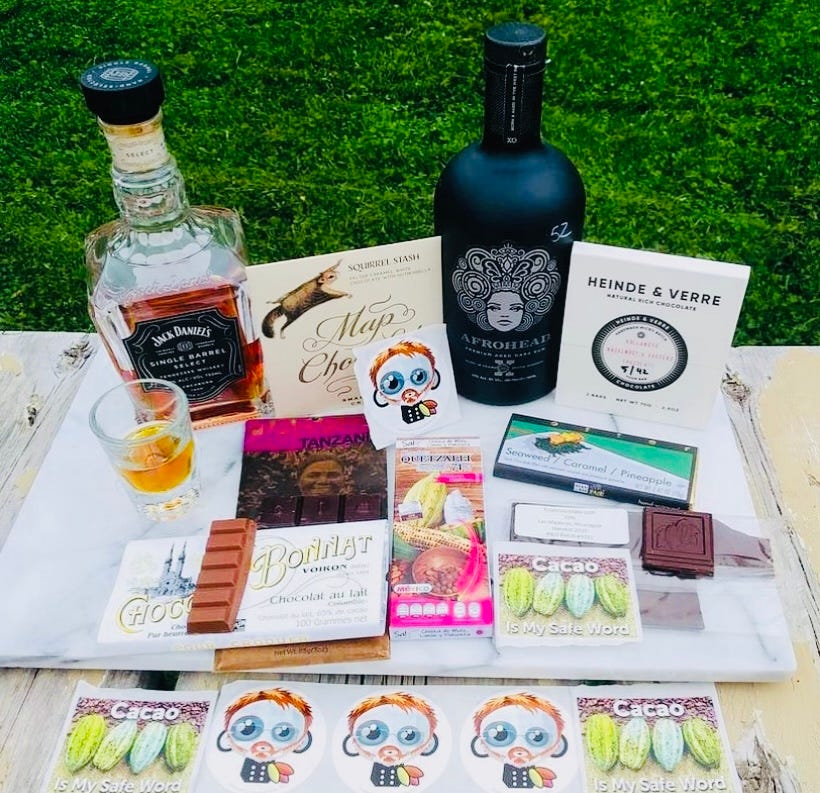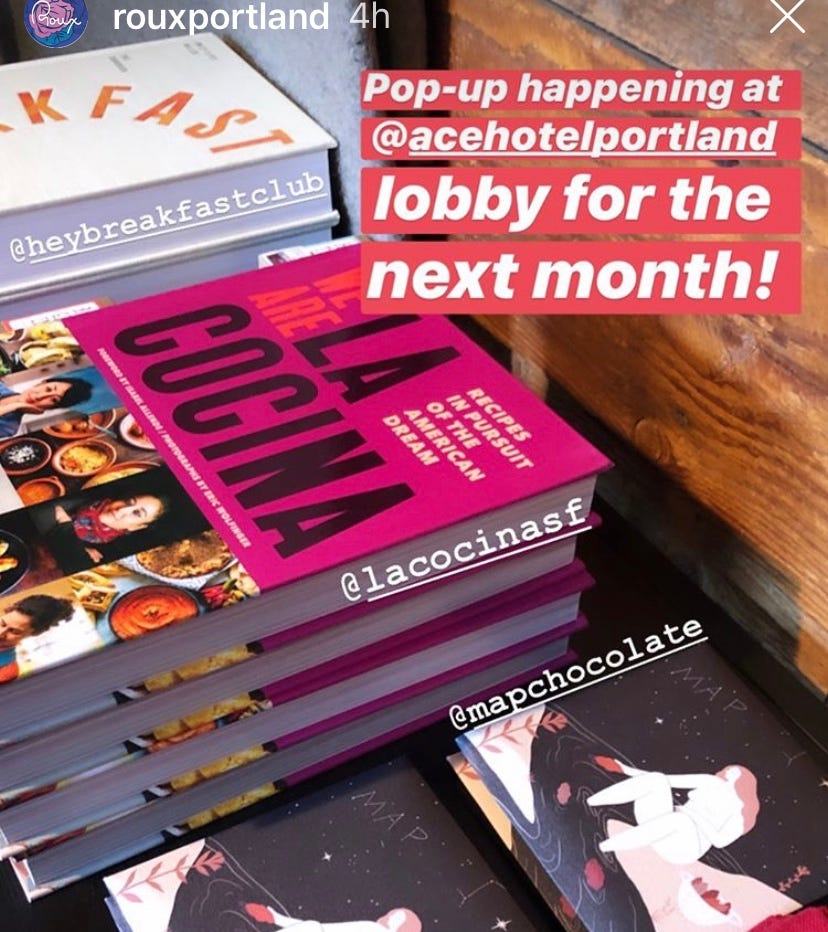building the chocolate business of your dreams
begins by reclaiming the one you've already started, or clarifying the one you want to start
I came across a recent article by the experienced, and generously wise, folks behind Pilot Light Consulting that I hope will be useful to those of you who are feeling the slog of making chocolate only getting heavier with the new economic realities, and useful for those of you just starting out. (please note! the original link I provided was incorrect; the one above has been corrected :)
Anyone who tells you the bean to bar business journey is easy, has never made bean to bar as their livelihood.
That said, it can be worth every step. Making it worth every step is the goal, right? How we take those steps, and the unforeseen directions they lead us, is unique to each maker. Anyhoo, this article is so useful it made me wonder (for one, solitary wingbeat) if I might want to re-think leaving bean to bar behind.
This quote in the article stopped me cold, because I’ve been there, 100% (and, very recently :)
“I feel like I’m running harder than ever just to stay in the same spot.”
About Pilot Life Consulting: they are an “independent restaurant consulting group specializing in launching new food and beverage businesses and food programs for hospitality and retail businesses.”
Don’t let the word “restaurant” part put you off: bean to bar chocolate is food. Food has its very specific needs and stumbling blocks.
Lots of folks come into bean to bar having never worked “in food,” which can lead to the obvious concerns like food safety issues (allergens, contamination avoidance measures, etc), presentation ignorance (bare hands touching + wrapping bars leave fingerprints, etc), and even lack of understanding of kitchen needs/equipment (like grease traps: anytime chocolate goes down a drain it leaves grease (cocoa butter) which can clog and break sewage lines (not pretty). If you are new to working in food, at a minimum take a food handler’s course.
In Pilot Light’s post (here on Substack their publication is called How my Restaurant Works) they offer three steps that offer a straightforward blueprint. It’s so spot-on I’m applying it to my next venture(s) to decide which new path I will choose to follow, and the steps I may need to take. I link to the post at the bottom, so feel free to skip ahead on down there.
Here are the steps. My fav is number 3 :)
Re-align your why
List assets and liabilities
Map a path to profitability
Going to be brutally honest here, which as always, you can take it or leave it.
It’s getting harder to succeed as a small batch craft, bean to bar chocolate business, and I don’t believe that will change anytime soon, if ever.
We can’t change how much our ingredients cost, or how much more difficult they may continue becoming to source. We have no control over the rising cost of packaging, or the increasing tightness of the budgets of those who buy our products. We can’t control newly-emerging well-funded bean to bar start-ups with the resources to be in the spotlight everywhere doing everything chocolate all at once.
We, or I need to say now, YOU, do have 100% control over making your chocolate dreams come to life and thrive.
But you need to do some work.
Seriously! Put down the phone and stop scrolling Instagram or those chocolate Facebook groups. Put as much thought and care into figuring out the truly important parts as you do entering the competitions or traveling to origin because that’s just what everyone does. Take the money you’d spend on the class taught by the equipment manufacturer who offers it solely to upsell new equipment, and set it side for the day you start realizing you love making chocolate but the numbers aren’t working: number of hours, costs, the number of bars you (and if you’re lucky, your team) can make aren’t adding up to the beautiful dream you’d thought you were creating.
My biggest chocolate problem was high demand.
By 2018 I already had more wholesale than I could handle, so I strategically axed a bunch of accounts and shifted the numbers to retail; that was a smart move, and helped with profitability, but it meant more work. Every one or two bar order takes the same amount of time to fulfill (pack and ship) as a ten or twenty bar order. A four or five-hundred bar order for wholesale takes more time to pack and ship, but creates bigger cash flow. Cash flow = paying bills, ordering supplies, etc.
Collabs with pastry chefs helped with creating more demand. My bars in the spotlight in places I never imagined they’d land also created more demand.
Ever heard of “too much of a good thing”? I had more demand than I could manage without hiring employees (the n1 cost of a business is payroll). To afford employees I’d need more demand, and more demand would mean bigger equipment, and a bigger space. I know I’m not the only small batch maker to face this hamster wheel.

Was my dream being the manager of a small chocolate factory? Nope.
One big problem: I didn’t have the resources for the hamster wheel. No family members who might invest in the business or float my expenses. I’d worked hard for my business savings, and they were important to me, but they were laughable compared to the big craft makers. I was afraid of didn’t like the idea of taking on investors who would, as they most often do, steer me toward making chocolate like everyone else was making or in the direction they thought their investment should go.
On one hand, I had a dream, and on the other, I had choices to make. I was splitting my year between making chocolate nonstop and teaching it: hard to do both simultaneously, but at the time I did.
I was a bird torn between two directions: one wing wanted to flap toward the direction of a small batch dream that seemed impossible but also, was so woven into my “why I make chocolate” it was like a GPS beeping for me to follow it. The other wing wanted to fly toward helping other makers achieve their dreams.
I chose to downshift making bars and increase my efforts and time teaching. Hoping, worrying, trying to help small batch makers grow and make their way. Some of you have. Some of you are crafting mind-blowing, delightful chocolate and running successful businesses, clearing the hurdles.
For some of you it will catch up. By it I mean, the impetus for sameness. You will feel stressed/tired/confused and look at who might be “doing it” better than you; this is how best to let go of, and lose, your dream. This is why zillions of small businesses peter out. You may wonder Maybe they know something you don’t? What about those awards they won? Maybe make that peppermint bar they made. That guy in the FB group seems like he’s onto something. Maybe make the 70% rectangular one like he makes.
Ten years ago craft makers did not make bonbons. The big craft makers (and the self-proclaimed experts who promoted them) looked down on white chocolate and milk chocolate. Inclusions were weird and “out there.”
I was told more than once—by makers and experts—that those approaches weren’t craft. I stubbornly believed in doing my dream my way. This was what a then well-known chocolate expert wrote to me, at the start of 2016.
We are generally in a cycle of wanting chocolate that is anchored in traditional desirable flavor sets with occasional surprises revealing themselves. The market is still proving itself to consumers and they still need things that they can relate to as chocolate in some way. We've come a full circle and are pushing towards more traditional flavors as the market blazes new trails in funky flavor sets.
He was wrong, obviously. Very wrong, and is no longer in business. Consumers could not then, nor now, “relate” to “70% Piura Blanco” or even “dark milk 60% Belize” because they have no effing idea what that is if they’re new to craft. They might not have fully grasped what “dreamy hints of moonlight & friends” meant, but it made them curious, it wasn’t intimidating, and so they reached for it.
But at the time that guy wielded influence, and power. Made me wonder for half a second if I should quit and then I got back to creating what I was here to create. A year later the look on his face at my booth at NW Fest—he watched from behind a mob, couldn’t reach my swarmed table, and when he finally made his way through the crowd, apologized to me—was worth every tear I’d shed in my own personal Like Water for Chocolate mini series.
It is hard to be a visionary, which is why we are so few and far between. I own my role in that; can’t help it, it’s who I am and what I brought to craft chocolate. Many people aren’t fans of people who see differently (in chocolate or otherwise), so there’s also that. I’m not asking you or telling you that you need to be a visionary: I am telling you to clarify and grab hold of why you started making chocolate.
That why is your vision.
More than that, I’m saying dreams need both wings working together to reach our vision. That’s the clarifying it part. The hard work part. The asking a credible source for help part.
I want to live in a world with small batch chocolate. I can only hope, now that I’m leaving chocolate making as my profession behind, that you do too.
Read this and do the steps. Yes, actually. Do.the.steps.
One other thing, when you’re done reading it, remember to thank the folks who created it by using the ❤️
To support my work here (thank you!) you can leave a tip for me over on Kofi.
Here’s to your next amazing batch,
Mackenzie







Thank you so much Mackenzie for your very insightful and useful words.. I am definitely needing to take a bit of time to look at my ‘why’ and it is hugely helpful to know I am far from alone in feeling a bit discombobulated about it all!
I have loved how you've always paved your own path.
I also want to live in a world that has craft chocolate. Thanks for all you do to help the makers!
honestly can't believe the comments from that "expert". It was already clear in 2016 that it was 100% bars and unusual flavours/inclusion that were the way to get attention and purchase.